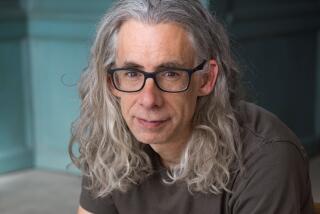âStorm Seasonâ: Wild, Original and Gorgeous : THE STORM SEASON, <i> by William Hauptman,</i> Bantam Books, $19.50, 306 pages
âThe atmosphere is a mirror,â one person remarks in this wonderful novel. âIt reflects not only conditions on land but the temperature and circulation of ocean currents. When you study the atmosphere, you study everything.â
The speaker here is a Nebraska minister who drives hundreds of miles to get next to tornadoes; his companions--hanging out in a Dairy Queen in a town in the middle of North Texas, Oklahoma Panhandle Nowhere--are railroad men, taking âpersonal holidays,â out on their own tornado excursion.
This first novel is about so much that it in its own way is like a tornado, sweeping up everything it passes over into a well-constructed furious funnel.
âThe Storm Seasonâ is about family, the working class, the crimes human beings have committed against the land and the hypnotic, redemptive quality of disaster--why human beings love being scared out of their socks. Itâs spooky, beautiful, bizarre.
Burl Drennan is the younger son of Willie Drennan, an independent oil man in the ugly town of Nortex (in North Texas.) Willie strikes oil, makes money, takes to drink, loses money. He is full of lofty thoughts about reincarnation and has seen a UFO. Burlâs mother is long-suffering Doris, along in life for the ride.
Burl also has an older brother, Coy, who smokes dope, hates the Vietnam War, incurs his fatherâs wrath but later marries, has a kid, builds a brick house for his family and dabbles in dubious banking. Coy strives for the normal. He wants, somehow, to get out of this life in one piece, unscathed.
But all around the Drennan family, the land, the atmosphere, the animals, the industries, the enterprises, give the lie to that forlorn hope.
North Texas is tornado country. Just up the road--give or take a few hundred miles--a factory puts together all the atomic bombs made in this country.
Coyotes and rattlesnakes love this place. The ground itself is riddled with working and abandoned oil rigs. Itâs weird out here. The air itself is alive, intelligent, moving restlessly in storm fronts, constructing âsuper cellsâ that turn into tornadoes.
The world is so alive that Burl--because he allows himself to consider such things as cancer and the atomic bomb--can hear, sometimes, âmolecules singingâ in the roof of his car.
The whole of North Texas, and Oklahoma, and probably the world, is on a raging tear.
Instead of running from this, Burl--who sobbed as a child in closets when storm warnings came--realizes, after the Big One comes and destroys much of Nortex, that the best thing to do with these dangerous mysteries is to pursue them.
Burl is all that his brother is not. Heâs a rock musician. He does a lot of crystal meth. He works on the railroad. He takes up with an American Indian woman. He doesnât care anything about money. But mainly, heâs enchanted by these tornadoes, which imply so much more to existence than his family is willing to recognize.
Burlâs best friend, John, another railroad man, tends to see the world in human terms. He rants and raves against the rich, against âgrandmaâ Ronald Reagan. John craves peace, quiet, a log cabin.
Burl, who lives for months in the Sands Motel in Nortex and then in a house with asbestos siding, yearns for metaphysical answers--about how to be part of something bigger, about what the nature of death and life can be.
He wants to understand our existence here on Earth, and what the Earth thinks of us. To that end, Burl chases those tornadoes, in his hail-battered red Mustang, searching for visions.
I donât think a review can do justice to this book. Itâs wild, gorgeous, original, loving, strange. Read it.
Next: Constance Casey reviews âChildren of the Dream: The Psychology of Black Successâ by Audrey Edwards and Craig K. Polite (Doubleday).
More to Read
Sign up for our Book Club newsletter
Get the latest news, events and more from the Los Angeles Times Book Club, and help us get L.A. reading and talking.
You may occasionally receive promotional content from the Los Angeles Times.








